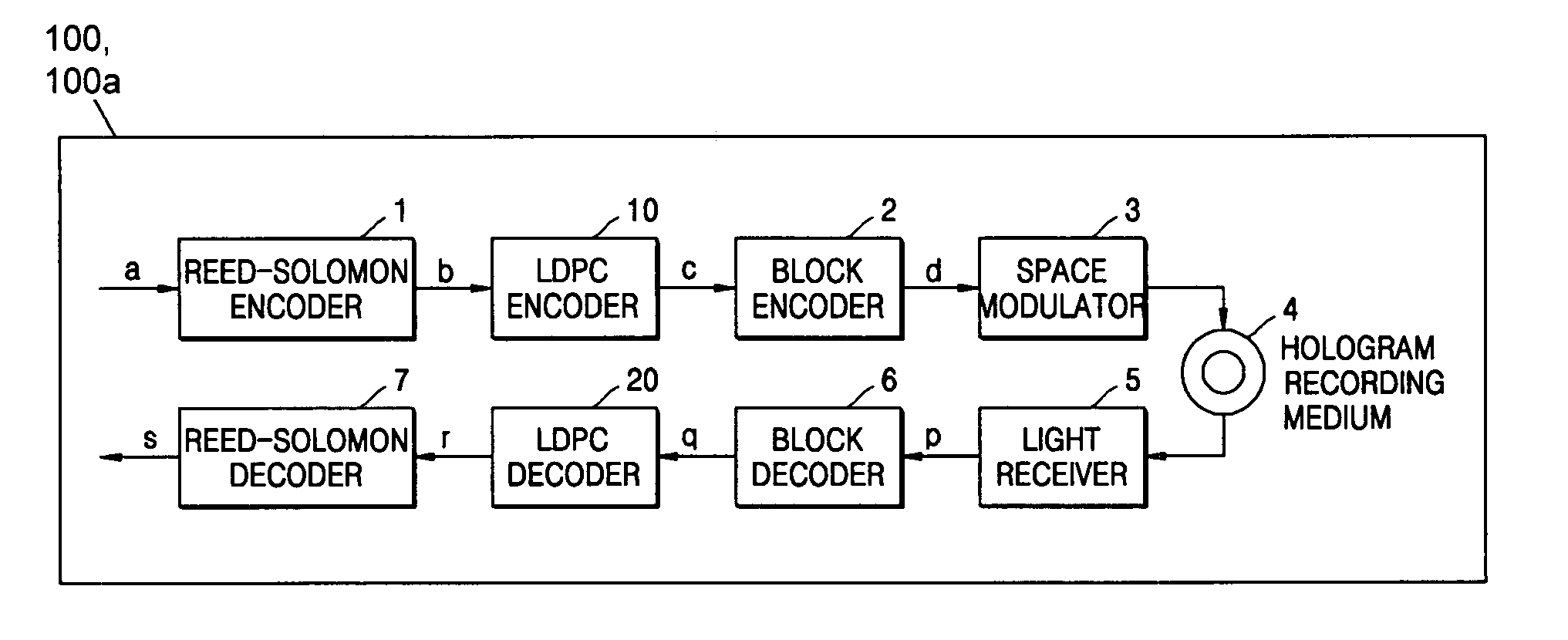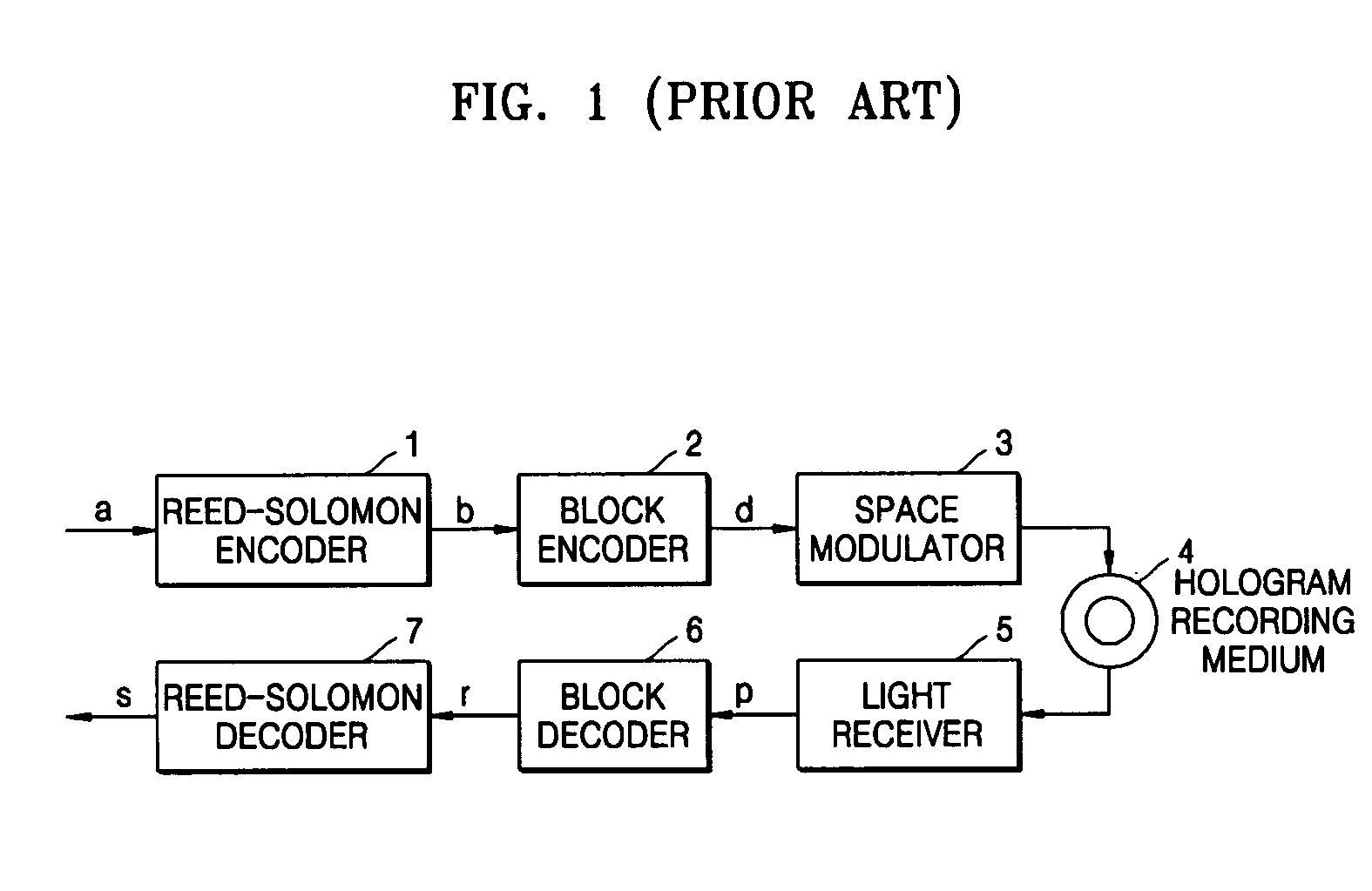Hologram recording and reproducing apparatus and hologram reproducing apparatus
a recording and reproducing apparatus and a technology for reproducing apparatus, which are applied in the direction of digital signal error detection/correction, instruments, coding, etc., can solve the problems of reproducing signals, reproducing signals, reproducing signals, etc., and achieves high reliability and reduce decoding errors.
- Summary
- Abstract
- Description
- Claims
- Application Information
AI Technical Summary
Benefits of technology
Problems solved by technology
Method used
Image
Examples
first embodiment
[0044] Referring to FIG. 7, a signal processor of a hologram recording and reproducing apparatus 100 and a hologram reproducing apparatus 100a according to a first embodiment of the present invention includes, a Reed-Solomon encoder 1, a low-density parity check (LDPC) encoder 10, a block encoder 2, a space modulator 3, a light receiver 5, a block decoder 6, an LDPC decoder 20, and a Reed-Solomon decoder 7.
[0045] The Reed-Solomon encoder 1 encodes recording data a using a Reed-Solomon code and generates a recording Reed-Solomon code b. The LDPC encoder 10 encodes the recording Reed-Solomon code b using an LDPC code and generates a recording LDPC code c.
[0046] The block encoder 2 encodes the recording LDPC code c using a block code and generates a recording block code d. The space modulator 3 transmits or intercepts object beams of respective pixels, and generates recording-page data having a checkered pattern corresponding to the recording block code d. A hologram recording medium...
second embodiment
[0065] Although a differential code is used as the block code in the first embodiment, a 2:4 code may also be used. An encoding rule of the 2:4 code is illustrated in FIG. 9 and an example of the recording-page data is illustrated in FIG. 10.
[0066] In this case, the block decoder 6 compares the brightness levels of four pixels constituting code words of the 2:4 code and sets levels of the pixels to P1, P2, P3, and p4 in order of increasing brightness. The level difference Δ may be given by, for example, equation 28, equation 29 or equation 30. Δ=p1-(p2+p3+p4)(28)Δ=p1-p1+p2+p3+p44(29)Δ=p1-p2(30)
[0067] Referring to FIG. 9, when the brightness level of the right-upper pixel is highest, the reproducing block code {circumflex over (d)}, which is an estimated value of the recording block code d, is given by equation 31 and the reproducing LDPC code ĉ, which is an estimated value of the recording LDPC code c, is given by equation 32. d^=[0100](31)c^=[01](32)
[0068] Since the estimated re...
third embodiment
[0070] A code (hereinafter, referred to as a 5:9 code) in which two of nine pixels are “1” and the other seven pixels are “0” may be employed as the block code. An example of the encoding rule of the 5:9 code is partially illustrated in FIG. 11.
[0071] In this case, the block decoder 5 selects two of the nine pixels constituting a code word of the 5:9 code in order of increasing brightness, and it is assumed that the levels of the two selected pixels are p1 and P2 and that the levels of the other seven pixels are p3, p4, P5, P6, P7, P8, and p9. The level difference Δ may be given by any one of equation 34, equation 35, or equation 36. Since 8 may be expressed as 23, that is, a power of 2, the number 8 is set as a denominator of the second term in the right side of equation 35 and equation 36 for easy division in a digital circuit. When the reproducing signal p passes through a high-pass filter, the second term in the right side of equation 36 is almost 0 and is removed, and thus the...
PUM
| Property | Measurement | Unit |
|---|---|---|
| density | aaaaa | aaaaa |
| brightness | aaaaa | aaaaa |
| signal-to- | aaaaa | aaaaa |
Abstract
Description
Claims
Application Information
 Login to View More
Login to View More - R&D
- Intellectual Property
- Life Sciences
- Materials
- Tech Scout
- Unparalleled Data Quality
- Higher Quality Content
- 60% Fewer Hallucinations
Browse by: Latest US Patents, China's latest patents, Technical Efficacy Thesaurus, Application Domain, Technology Topic, Popular Technical Reports.
© 2025 PatSnap. All rights reserved.Legal|Privacy policy|Modern Slavery Act Transparency Statement|Sitemap|About US| Contact US: help@patsnap.com



